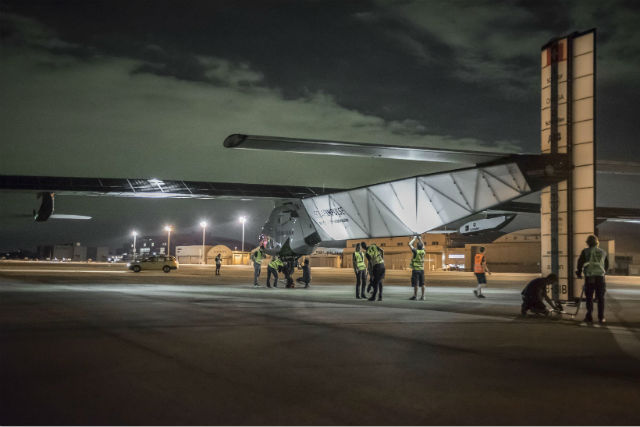Bad news turned worse for the Solar Impulse round-the-world flight attempt as estimates of the time needed to repair “irreversible” battery damage caused by overheating jumped from “two to three weeks” to “several months” – leaving the all-solar aircraft grounded in Hawaii until spring 2016.
While Solar Impulse 2 smashed all solar-powered crewed flight endurance records on its five-day/five-night leg from Nagoya to Hawaii, the effort overcooked its batteries. On the aircraft’s arrival at Kalaeloa airport on 3 July, engineers thought repairs could be made in less than three weeks – but now say they need several months and added, via Twitter, that with “late season weather conditions and shorter days, #Si2 won’t move before April 2016”.
Engineers will, however, take advantage of the delay: “In parallel, we will be studying various options for better cooling and heating processes for very long flights.” Post-maintenance check flights will start in 2016 to test the new battery heating and cooling systems.
The problem started when the aircraft took off from Nagoya on 29 June: the batteries got too hot as the aircraft ascended, owing to “over insulation”. According to Solar Impulse, the ground team watched the situation, but had no way to decrease the temperature later in the flight – each 24h cycle requires that the aircraft ascend to 28,000ft during daylight hours, when sunlight charges the batteries, so it can gradually descend during the night as battery power runs down.
The flight to Kalaeloa airport in Hawaii was the project’s second attempt to make its planned half-Pacific leg. After SI2 departed Nanjing on 30 May, looming bad weather over the ocean forced a diversion to Japan, where the aircraft waited a month for a clear forecast.
In the event, the trip to Hawaii broke all records for manned solar-powered flight, at 117hr 52min and 7,212km. Pilot André Borschberg, working alone in the single-seat cockpit, could rest for no more than 20min at a stretch – and then only at lower altitudes, when an oxygen mask is not needed in the unpressurised cockpit. That cockpit is just 3.8m3 and subject to external temperatures ranging from -40°C to +40°C.
Bertrand Piccard, Borschberg’s partner in the project, will take the controls for the next leg, to Phoenix, Arizona. From there the plan is to reach New York in two legs, then cross the Atlantic to either North Africa or southern Europe before returning to Abu Dhabi, where the flight began in early March.
SI2 flies at altitudes of up to 8,500m and at speeds of 27-54kt (50-100 km/h). The aircraft has a wingspan of 72m (a Boeing 747-8I comes in at “just” 68.5m), but weighs a mere 2,300kg (5,071lb) – about the mass of a car – including its 633kg load of lithium batteries and the 17,248 solar cells on its horizontal surfaces.
Being large and delicate makes secure storage no small task. On some stops the team has made do with a portable, inflatable hangar. But while grounded in Hawaii, SI2 is being hosted by the University of Hawaii and the Department of Transportation in its hanger at Kalaeloa airport.

SI2 being readied for departure from Nagoya, 29 June 2015
Rex Features
Source: FlightGlobal.com




















